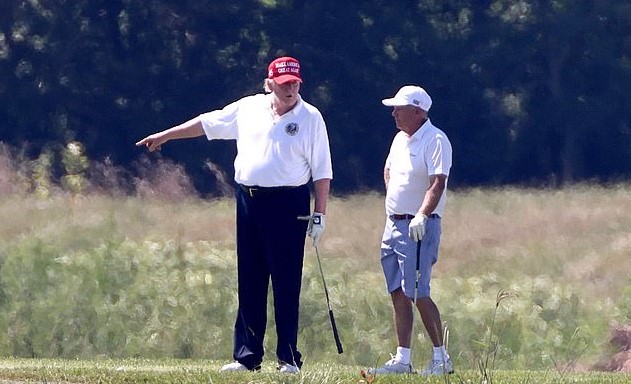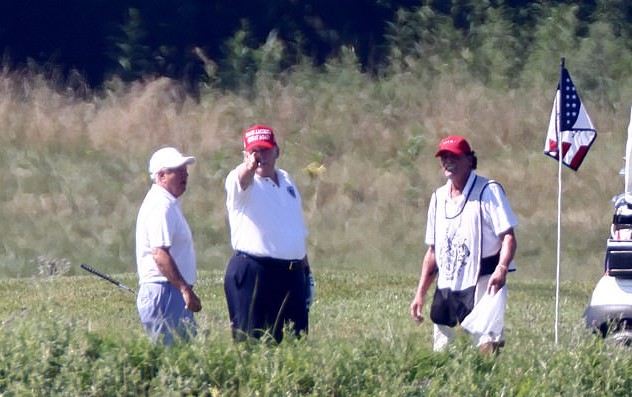President Trump returned to the golf course today as news broke that his administration is trying to block billions of dollars for states to conduct testing and contact tracing in the upcoming coronavirus relief bill.
The administration is also trying to block billions of dollars that GOP senators want to allocate for the Centers for Disease Control and Prevention, and billions more for the Pentagon and State Department to address the pandemic at home and abroad.
Trump spent the day at his golf course in northern Virginia with a political confidant, Sen. Lindsey Graham of South Carolina, for a nearly four-hour outing.
The administration’s posture has angered some GOP senators, officials told The Washington Post, and some lawmakers are trying to push back and ensure that the money stays in the bill.
The officials, who spoke on condition of anonymity to reveal confidential deliberations, cautioned that the talks were fluid and the numbers were in flux.
The negotiations center around a bill Senate Majority Leader Mitch McConnell (R-Ky.) is preparing to unveil this coming week as part of negotiations with Democrats on what will likely be the last major coronavirus relief bill before the November election.
Negotiations are expected to kick off with increased urgency because of the rapid growth of cases — and steady uptick in deaths — in the United States. The number of cases began falling in April but accelerated sharply after Memorial Day, shattering records in the past two weeks.
In late May, there were fewer than 20,000 new cases of coronavirus reported each day. On Friday, there were more than 76,000 new cases reported.
The two political parties are far apart on a number of contentious issues, such as unemployment insurance, but the conflict between Trump administration officials and Senate Republicans on money for testing and other priorities is creating a major complication even before bipartisan negotiations get under way.
Some lawmakers are trying to reach a deal quickly, as enhanced unemployment benefits for millions of Americans are set to expire in less than two weeks.
One person involved in the talks said Senate Republicans were seeking to allocate $25 billion for states to conduct testing and contact tracing, but that certain administration officials want to zero out the testing and tracing money entirely.
Some White House officials believe they have already approved billions of dollars in assistance for testing and that some of that money remains unspent.
Roughly 3.7 million Americans have already tested positive for the coronavirus in the United States.
Wait times for test results can vary by state, but in some places people have to wait more than a week to find out if they tested positive.
Trump and other White House officials have been pushing for states to own more of the responsibility for testing and have objected to creating national standards, at times seeking to minimize the federal government’s role.
The last major coronavirus spending bill Congress approved, in April, included $25 billion to increase testing and also required the Health and Human Services Department to release a strategic testing plan. The agency did so in May, but the plan mainly reasserted the administration’s insistence that states — not the federal government — should take the lead on testing.
Several Senate Republicans including Sen. Bill Cassidy (R-La.) are exploring pushing a testing and tracing provision in the next stimulus package but are expected to meet resistance from the White House.
“Cases and deaths are now both rising again, including in many red states,” said Sam Hammond, a policy expert at the right-leaning think tank the Niskanen Center, which has been working with Senate Republicans on testing legislation. “Senate Republicans have asked for funding to help states purchase test kits in bulk. As it currently stands, the main bottleneck to a big ramp-up in testing is less technical than the White House’s own intransigence.”
Trump has repeatedly questioned the value of conducting widespread coronavirus testing, arguing that if there were fewer tests conducted, the number of infections would be lower. Coronavirus infections and deaths are on the rise in many states.
The administration is also seeking to zero out $10 billion in new funding for the CDC in the upcoming bill, while slashing spending for the Pentagon and State Department related to foreign aid, the person said.
Trump has been skeptical of State Department spending and foreign aid generally, but it was unclear why the Trump administration would seek to block money for the Pentagon for a variety of coronavirus-related expenses such as reimbursing contractors for providing paid leave to employees.
Congress has already approved roughly $3 trillion in new spending and tax cuts as part of its response to the coronavirus pandemic.
Some White House officials had hoped to keep the next bill at less than $1 trillion, but they also want to include numerous elements that could prove costly.
For example, Trump has demanded a payroll tax cut as part of the legislation.
And he also wants to include another round of stimulus checks, though lawmakers are split on how to design new payments.
White House officials have been sharply critical of the CDC’s performance during the pandemic, complaining that its initial testing efforts were faulty and that it didn’t know more about the virus earlier this year.
At the same time they push cuts in testing and CDC funds, administration officials are trying to use the spending package to fund priorities that appear not directly related to the coronavirus — including a new FBI building, which has been a longtime priority for Trump, according to people involved.


